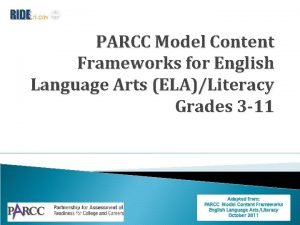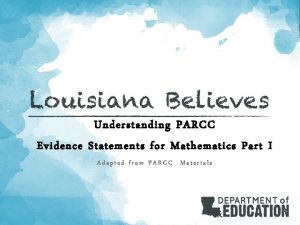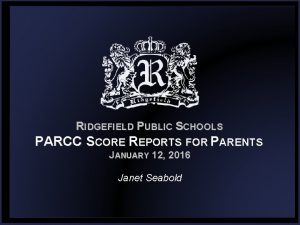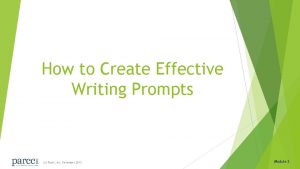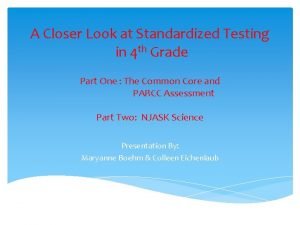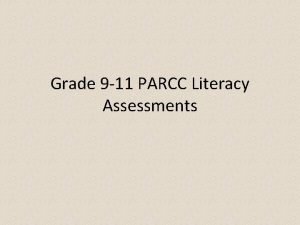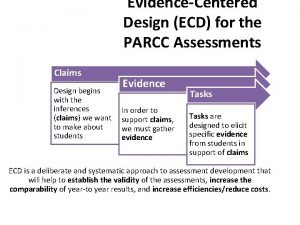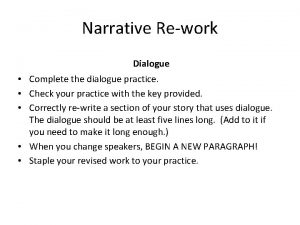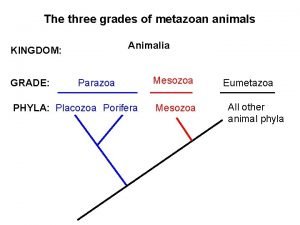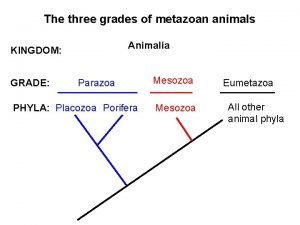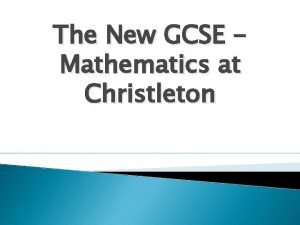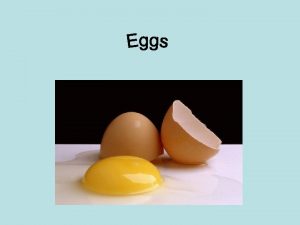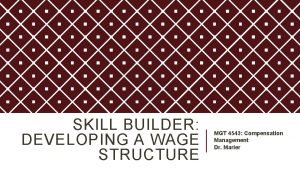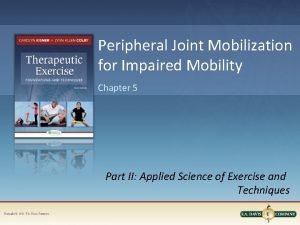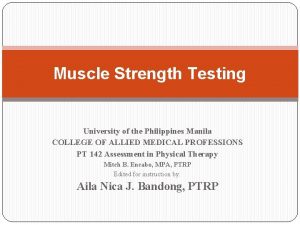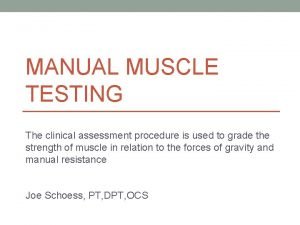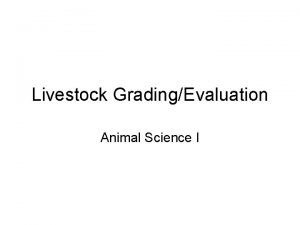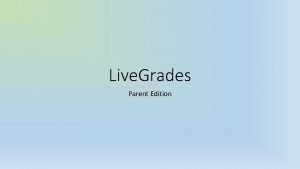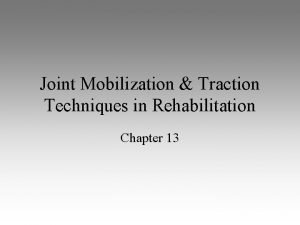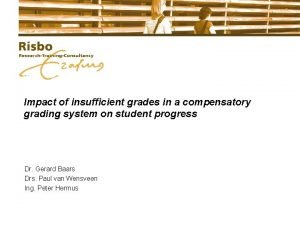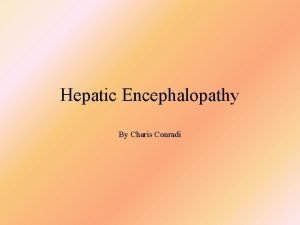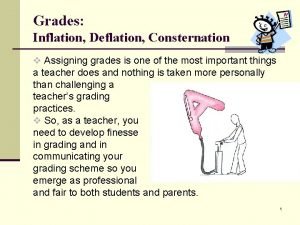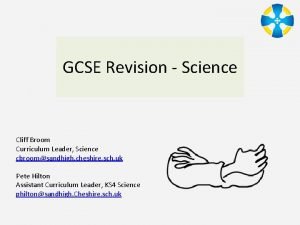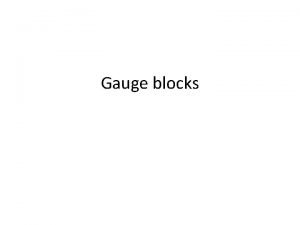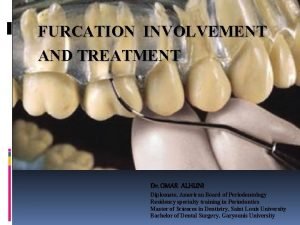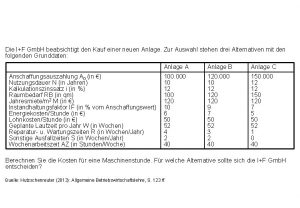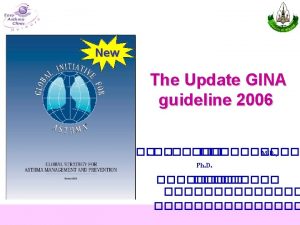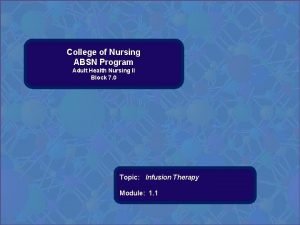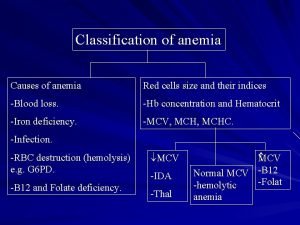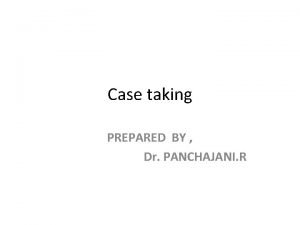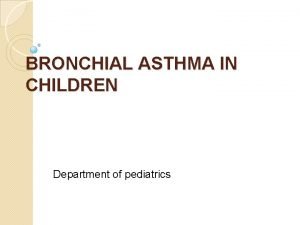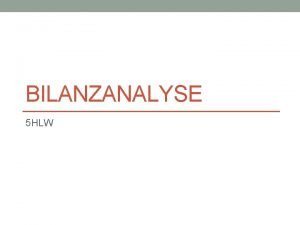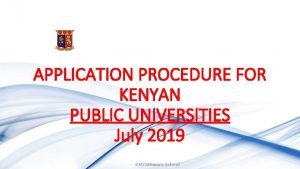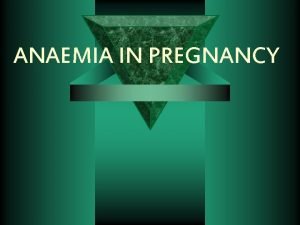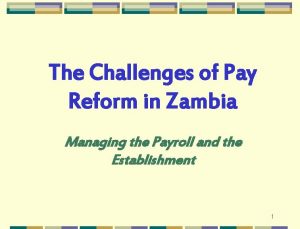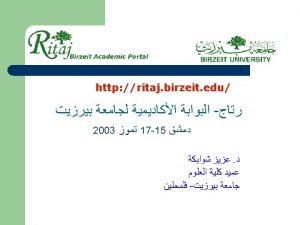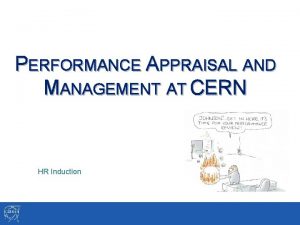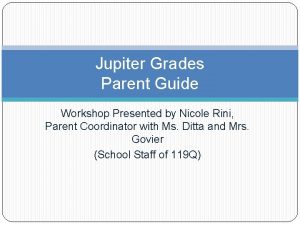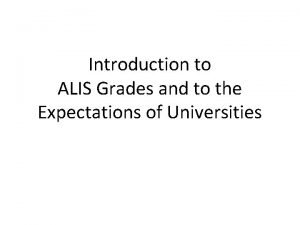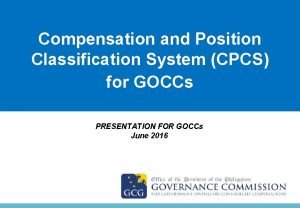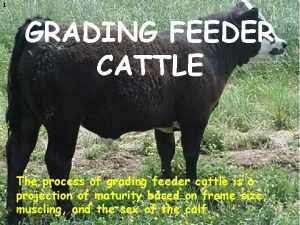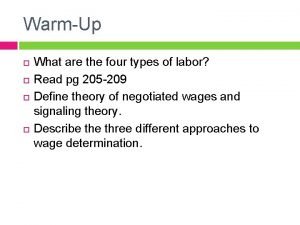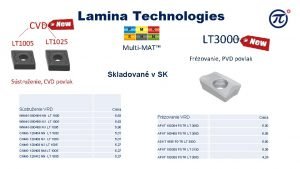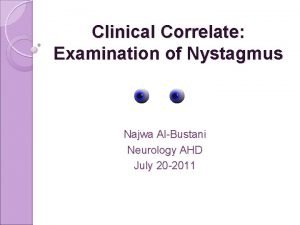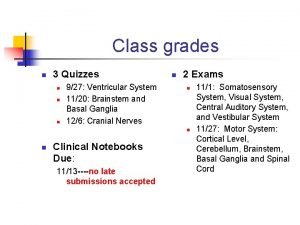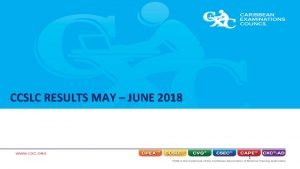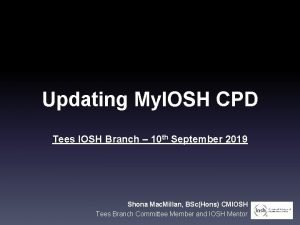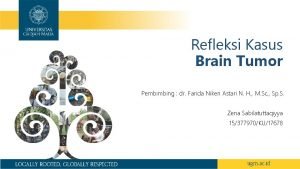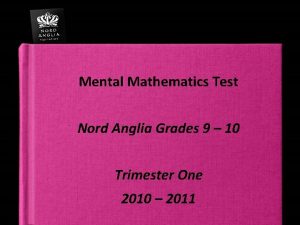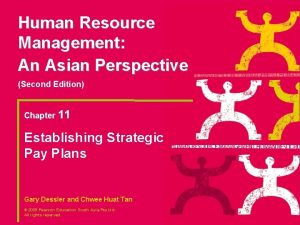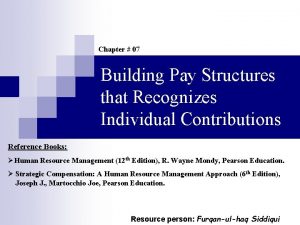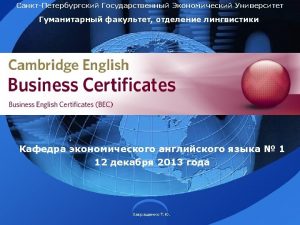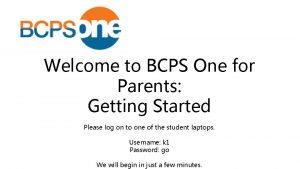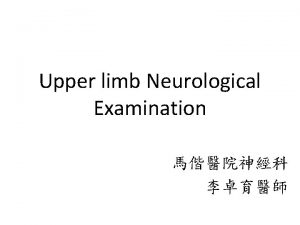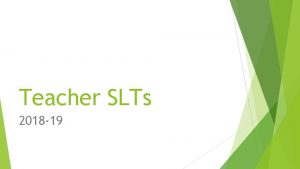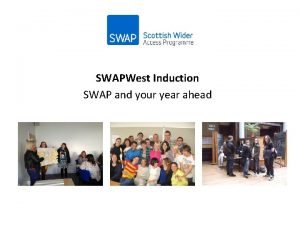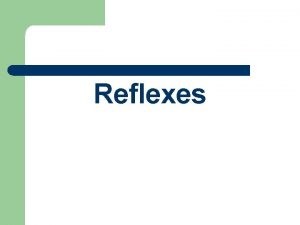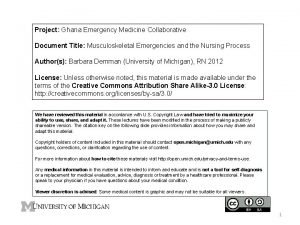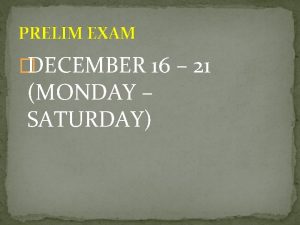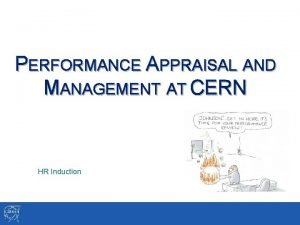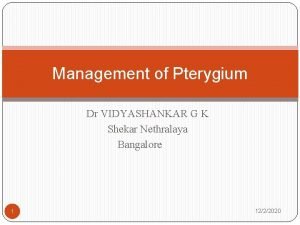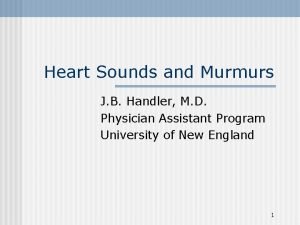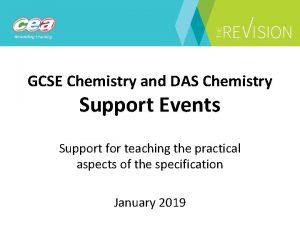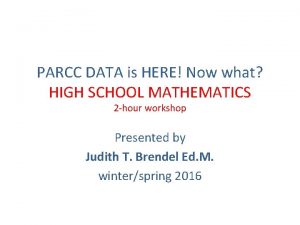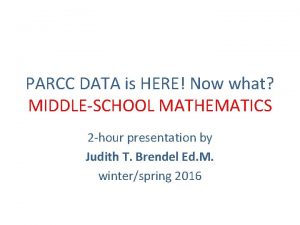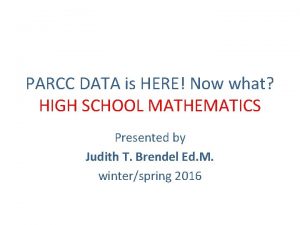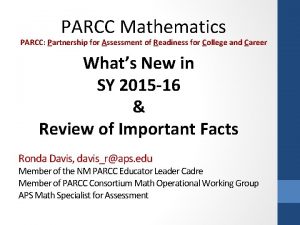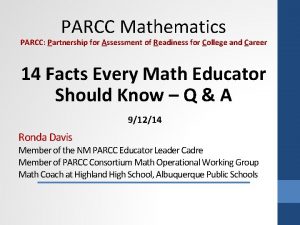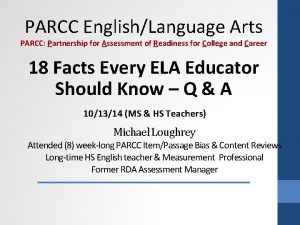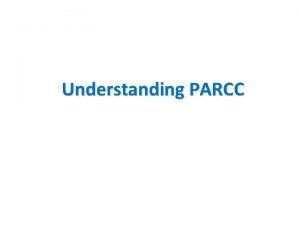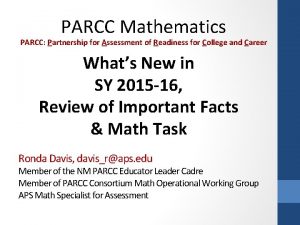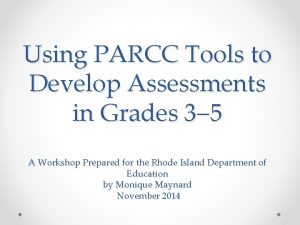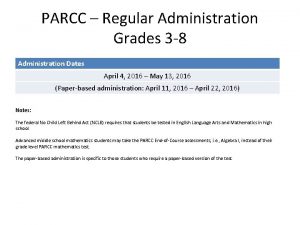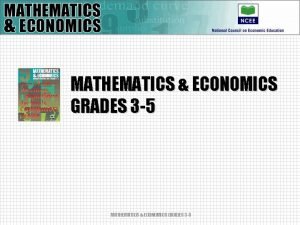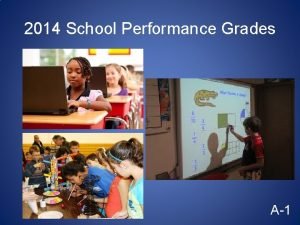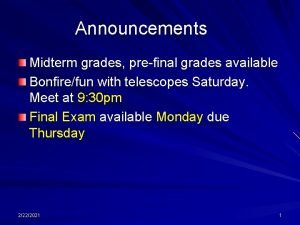PARCC DATA is HERE Now what Grades 3


































































![RESOURCES grades 3 -8 Understandthescore. org/help-your-child/resources-forparents … scroll down to Great!KIDS 1) Select [state] RESOURCES grades 3 -8 Understandthescore. org/help-your-child/resources-forparents … scroll down to Great!KIDS 1) Select [state]](https://slidetodoc.com/presentation_image/2072e7fbb0c0917042ecf84dfd90c66e/image-67.jpg)













































- Slides: 112

PARCC DATA is HERE! Now what? Grades 3 -5 SCHOOL MATHEMATICS full-day presentation Presented by Judith T. Brendel Ed. M. winter/spring 2016

AGENDA • • DATA … RESOURCES … SUCCESSFUL STRATEGIES What Do We Know About the NJ State Data? What are parents told? What can they access? What PARCC data resources can teachers access? PLDs: What are they; access for your class(es) Analyze data; estimate new year results Find RESOURCES to use with your students Experience DIFFERENTIATED ACTIVITIES to improve student engagement and understanding.

Year One Data Analysis Plan: DRILLING DOWN

Moving Forward with PARCC Data Teachers can use spring 2015 data to • Analyze – their whole class – each students’ performance by level – each students’ performance by specific questions and standards from their test. (available March 2016) • find released test questions that match last spring’s test • evaluate the instructional tools, strategies, methods and interventions they are implementing in the classroom and adjust, as needed. • access and use researched-based online content resources, activities, games, strategies.

HOW do you MAKE SENSE of the DATA?

STATE-WIDE RESULTS

PARCC Statewide Results • • • In the 2014 -15 school year, approximately 850, 000 students across New Jersey took the PARCC assessments. … nearly 99% of New Jersey’s students took the PARCC test on computer platforms, a percentage that led states in the PARCC consortium and positions New Jersey schools to be a national leader in integrating educational technology in classroom instruction and preparing students for the technology expectations in college and careers. This in itself is a great success story in terms of improving educational outcomes. Source: “The PARCC Assessments: Informing Teaching and Learning” (NJDOE October 20, 2015, page 5) http: //www. state. nj. us/education/assessment/parcc/informing. pdf

4 MAIN REPORTS (handout: Digging Deeper chart)

New Packet Pages 5 -9 Individual Student Report

New Packet pages 10 -11 District Summary of Schools Report • National, State, District, … Schools (% Levels 1 -5) • Number of Students who took the assessment • Math Total Overall Score Average (i. e. , 747) • % of students at each level in each math “Claim” (A-Major. B-Supporting. C-Reasoning. D-Modeling)

New Packet pages 12 -13 Claims w Arrows Student Roster (sample: grade 8) For the ENTIRE SCHOOL (data listed ‘above’ individuals) You can click for more details about EACH TEST ITEM - Standard (RL 2) - Format of question (selected response) - Number of students who responded to this item (87) - Evidence Statement (Provide a summary of the text) ELA item

New Packet page 15 District Summary of schools Mathematics Algebra-I 2014 -2015 #students Average overall Major content Supporting PARCC State District 1 Reasoning Modeling 2 3 4 5 Sample School 1 Sample School 2 Sample School 3 Levels explained Arrows explained

Student Roster ITEM score (all students in a particular school) • • School Name Average Overall Score of all tested students (i. e. , 183) Listing of each test item and maximum points for each Average # points students received for each test item 72% 80%


Before seeing any scores, what would you have estimated ? Write down % of your students’ with total avg. that would: MEET or EXCEED expectations (levels 4 -5) ALMOST meet expectations (level-3) Did NOT or PARTIALLY meet EXPECTATIONS (levels 1 -2)

NJ’s 2015 PARCC SCORES: MATH Grade 3 0% 20% 40% 60% 80% 100% source: http: //www. nj. com/education/2015/11/student_parcc_scores_are_coming. html

NJ’s 2015 PARCC outcomes Mathematics State SPRING 2015 results Which grade level do you think was the strongest? Why? Which grade level(s) or course the weakest? Why? not representative of grade 8 performance as a whole. Note: numbers may not sum to 100% due to rounding.

CANNOT COMPARE We cannot compare PARCC results to previous tests (NJASK, HSPA) NJASK 3 -8 PARC C befo r SPRIN e G 2015 WHAT CAN YOU COMPARE?

Algebra I PARCC Outcomes vs CLASS Grades Source: PARCC: NEXT STEPS “Measuring College and Career Readiness” (NJ State Board of Education, November 4, 20 What in-class assessments could you compare to your student’s PARCC scores?

What you can do NOW! (*Activity #1) FORM: PLD Major claim A, Supporting claim B FORM: EOY Examples chosen (MC, MMC, CR, Part A, B, …O http: //parcc. pearson. com/practice-tests/math/ 1) Select PARCC content you have already taught this year (from 2014 EOY paper/pencil practice test; access online). No/Calculator. 1) Use Answer Key and PLDs to assist in your selections; circle choices (hardcopy: first sheet right side of folder) 1) Create a 1 -period test with those examples.

Include VARIETY question formats MC multiple-choice (select A, B, C or D) “MS” multiple-select (select the “ 2” [3][4] correct answers) __ CR constructed response (fill-in answer) OE open ended (Parts A, B, …. ) Compare Data given data in different forms (equation, table, graph, scenario) with/without context Focus Major and Supporting content no calculators

What you can do NOW! (*Activity #1) ONLINE: http: //parcc. pearson. com/practice-tests/math/ 3) Give your students this 1 -period EOY test. 3) Note individual strong/weak areas now. all. Discuss in your group; then share with See CCSS (standards) and Evidence Statements on answer key. What would you do after scoring this test? 5) Compare to their class grades (quizzes/tests) 6) PLCs with colleagues (curriculum, strategies) LATER ON Create other tasks, worksheets and assessments; focus on extended response (PBA) questions and online practice.

http: //blog. measuredprogress. org/blo g/parcc-scores-are-in-whats-next When you create an assessment: • “Scaffold items in increasing difficulty to help students incrementally apply mathematical concepts and skills for solving multi-step word problems. ” • “Use extended-response (ER) items to collect evidence of students’ ability to reason mathematically. Student responses serve as classroom examples of meeting expectations. ”

… MORE DATA

MATH: NJ vs PARCC average A comparison of the percentage of students who scored on grade level on PARCC math exams. Comparison of the percentage of students who scored on-grade-level on PARCC’s math exams. % 40 30 20 10 Source: Accessed on December 2, 2015 http: //www. nj. com/education/2015/12/nj_students_beat_the_parcc_average_on_most_exams. html#incart_river_home

hardcopy A NEW RELEASE March 2016

PARCC: Areas of Attention Source: PARCC Assessments: Informing Teaching and Learning (NJDOE October 20, 2015, page 8) http: //www. state. nj. us/education/assessment/parcc/informing. pdf

What Parents are Told about PARCC and PARCC DATA:

What Parents are Told: This test is just one measure of how well your child is performing academically. Other information, such as grades, teacher feedback and scores on other tests will help determine your child’s academic strengths and needs.

What Parents are Told How do the test scores this year compare to those in past years? The knowledge and skills tested this year are different - and in some cases more rigorous - than in the past. If your child’s score is different meet with your child’s than you expected, meet with your child’s teacher to understand what that means and teacher how you can help your child improve his or her performance.

How will my child’s school use the test results? Results from the test give your child’s teacher information about his/her academic performance. The results also give your school and school district important information to make improvements to the education program and to teaching.

HOW can I use the Math Scores? • The best way to make sense of these • scores is to compare them to the average for students who met the expectations and the average for students in your child’s school, district, and state. • Also, look at the information below the scores. How is your child doing in each area of mathematics? Ask your child’s teacher how you can give your child more opportunities to be challenged and how you can support his/her academic needs.

WATCH VIDEO “Understanding the SCORE REPORT”

Activity #2 - Watch the “New Video: Understanding the Score Report” Use form; write thoughts and questions. http: //understandthescore. org/help-your-child/resources-for -parents/ Teachers walk through the score report step-by-step. They let parents know what to expect and provide tips on how they can support their child.

What Parents Can Access (links on slide 37) Information and resources including sample PARCC test questions and the PTA’s Guide to Student Success. Visit How Can I learn more? Go to the PARCC website http: //www. parcconline. org When will I receive my child’s score report? During the first year of PARCC administration (2014 -2015 school year), score reports will be released in the fall of 2015. In future years they will come much sooner. http: //www. understandthescore. org

Parent Score Report (handout) ONE STUDENT’S DATA Showing a moc STUDENT: score … levels … and this student’s score compares to SCHOOL DISTRICT STATE PARCC average

Algebra-II (grade 10/11 Sample) INDIVIDUAL STUDENT REPORT

Parents see a Sample Algebra II Assessment Report, 2014 -2015 Source: PARCC “Mock Parent Score Report – Algebra 2” (2015) http: //parcconline. org/resources/educator- resources Next slides show data available about one particular Algebra-II student. (Algebra-I hardcopy; separate packet p. 5 -9)

FIRST NAME 8 M. LAST NAME 8 Date of Birth: 05/15/2000 ID: 9999 Grade: 9 SAMPLE DISTRICT NAME SAMPLE SCHOOL ONE NAME ILLINOIS

OVERALL PERFORMANCE (level w/graphic) OVERALL PERFORMANCE (level w/graph) Below, EACH LEVEL is explained for that particular grade level or high school course. See page-5

MATHEMATICS PERFORMANCE LEVEL 5 Your child performed at Level 5 and earned a score of 839 Students performing at levels 4 and 5 met or exceeded expectations. ALGEBRA-II SAMPLE

LEGEND Below expectations (Levels 1 or 2) Nearly Meets expectations (Level 3) Meets or Exceeds expectations (Levels 4 or 5) (To see selected questions from the test, visit understandthescore. org )

MAJOR CONTENT (sub claim A) In this area, your child did as well as or better than students who met the expectations. (Algebra-II) Students meet expectations by solving problems involving rational exponents, writing and interpreting algebraic expressions, rational and radical equations, graphs of functions, creating linear, quadratic, and exponential functions, and making inferences and justifying conclusions from data.

ADDITIONAL & SUPPORTING CONTENT (sub claim B) almost as well as In this area, your child did students who met the expectations. (Algebra-II) Students meet expectations by solving problems involving the complex number system, rational expressions and functions, systems of equations, trigonometric functions, interpreting data, and probability.

Expressing Mathematical Reasoning (sub claim C) In this area, your child did as well as or better than students who met the expectations. (Algebra-II) Students meet expectations by creating and justifying logical mathematical solutions and analyzing and correcting the reasoning of others. (generic)

MODELING & APPLICATION (sub claim D) as well as or better In this area, your child did than students who met the expectations. (Algebra-II) Students meet expectations by solving realworld problems, representing and solving problems with symbols, reasoning quantitatively and strategically using appropriate tools. (generic)

Grades 3, 4 and 5 Samples ALL STUDENTS

Grade 3: MAJOR CONTENT (sub claim A) Third graders are expected to learn: • Multiplication and Division: Memorize their times tables from 1 -10, multiply and divide within 100, and understand that division is the reverse of multiplication. • Two-step problems: Add, subtract, multiply, and divide to solve problems that take more than one step to answer. • Fractions: Understand that fractions are numbers, and find common denominators (the bottom number in a fraction). • Area: Find the area of a rectangle.

Grade 4: MAJOR CONTENT (sub claim A) Fourth graders are expected to learn: • Multi-step problems (with multi-digit numbers): Add, subtract, multiply and divide bigger numbers. • Fractions: Add and subtract fractions, multiply fractions by a whole number, and compare fractions. • Decimals: Convert fractions to decimals — and compare decimals to the hundredths place.

Grade 5: MAJOR CONTENT (sub claim A) Fifth graders are expected to learn: • Fractions: Add, subtract, multiply, and divid. E fractions — including fractions with different denominators (e. g. , 1⁄3 + 1⁄2) and mixed numbers (e. g. , 2 3⁄4 + 1 1⁄2). • Decimals: Add, subtract, multiply, and divide decimals to the hundredths place (e. g. , 0. 62 – 0. 41). • Place value: Multiply and divide using two-, three-, and four-digit numbers (e. g. , 324 x 24 or 4325 ÷ 12). • Volume: Understand what volume means, knowing the formulas, and finding a 3 -D shape’s volume.

Gr. 3: ADDITIONAL & SUPPORTING CONTENT (sub claim B) Third graders are expected to learn: • Number sense: Add and subtract within 1, 000. • Place value: Understand place value up to the hundreds place. • Graphs: Read (or create) graphs that represent data. • Measurement: Find area and length, and measure distances to the nearest quarter unit (e. g. 1⁄4 inch).

Gr. 4: ADDITIONAL & SUPPORTING CONTENT (sub claim B) Fourth graders are expected to learn: • Factors: Find factor pairs (all the pairs of numbers that can be multiplied to get a certain number). For example, the factor pairs for 12 are 3 × 4, 2 × 6, and 1 × 12. • Fractions: Add, subtract, multiply, and divide whole numbers and fractions to solve two-step word problems. • Geometry: Draw and identify angles, perpendicular and parallel lines, and right triangles. Find perimeter and area in word problems (and when one length is missing). • Patterns: Identify shape and number patterns and describe the rule for extending them.

Gr. 5: ADDITIONAL & SUPPORTING CONTENT (sub claim B) Fifth graders are expected to learn: • Measurements: Convert units within the same measurement system (e. g. , centimeters to meters). • Data: Interpret data and analyze relationships by creating simple equations, tables, graphs, and line plots. • Geometry: Classify two-dimensional shapes into categories based on their properties.

Gr. 6: Expressing Mathematical Reasoning (Sample of a sub claim C) The student expresses grade/course-level appropriate mathematical reasoning by constructing viable arguments, critiquing the reasoning of others and/or attending to precision when making mathematical statements. logical approach based on …. • a logical and complete progression of steps • precision of calculation • correct use of grade-level vocab. , symbols and labels • complete justification of conclusion • evaluating, interpreting and critiquing

Grade 6: (sample of sub claim D) MODELING & APPLICATION The student solves real-world problems with a degree of difficulty appropriate … by applying knowledge and skills articulated in the standards for … grade/course (or for more complex problems, knowledge and skills articulated in the standards for previous grades/courses), engaging particularly in the Modeling practice, and where helpful making sense of problems and persevering to solve them, reasoning abstractly, and quantitatively, using appropriate tools strategically, looking for the making use of structure and/or looking for and expressing regularity in repeated reasoning.

LEVELS? What do they all mean? What are they?

PLDs: Performance Level Descriptors Grades 3 -11 Reminder: PARCC reports results according to five performance levels that delineate the knowledge, skills, and practices students are able to demonstrate. These levels are: Level 1: Did not yet meet expectations Level 2: Partially met expectations Level 3: Approached expectations ---------------------------------Level 4: Met expectations Level 5: Exceeded expectations

I know what the SUB CLAIMS are But what are the expectations at different levels? What are they for MY class? See the PERFORMANCE-LEVEL DESCRIPTORS

Student’s Understandings at each PERFORMANCE LEVEL at each GRADE LEVEL A B Level 4 -5 3 C D F 1 -2

Sample PLD Grade 7 math partial What you can see: sample Sub-Claim A This grade-7 PLD has been updated since this slide was created. NOW, Level 2 says only to “recognize” not use proportional relationships. What are specifics for your grade/course? (next slides) HANDOUT right side folder

*ACTIVITY #3: PLDs for your grade level Major. Supporting. Reasoning. Modeling/Applying http: //parcconline. org/assessments/test-design/mathematics/mathperformance-level-descriptors (link on slide 60) 1) Performance-Level Descriptors by Grade Band: – PARCC Mathematics Performance Level Descriptors: Grades 3 -5, 6 -8, 9 -12 (PLDs hardcopy right side of folder or separate packet) 2) Find your grade level 3) Take notes each category: Major …. 4) Use PLD CHART to compare 2015 results w/estimates for 2016 (See next slide)

*Activity #3 w/PLDs (claims A-D) Compare grade X 2015 with grade X expected 2016 WHOLE CLASS 1. Pick one of your math sections for this activity (one class of students you have this year). 1. Find your grade-level (3 -8) (*hard copies) 1. Spring 2016 PLDs: For each standard √ check the level you think is the level that will be reached by the highest % of your students. 2. Spring 2015 PLDs: * the actual level most …. Standard Level 5 MAJOR CONTENT (SUB CLAIM A) Level 4 Level 3 Level 2 6. xxx √ * 7. yyy 8. aaa √ * Level 1

Resolution: ELA and Math Minimum Scores for Each Performance Level Partially meeting (Level 2) Approaching Expectations (Level 3) Meeting Expectations (Level 4) Exceeding Expectations (Level 5) Grade 3 ELA & MATH 700 725 750 790 Grade 4 ELA & MATH 700 725 750 790 Grade 5 ELA & MATH 700 725 750 790 Grade 6 ELA & MATH 700 725 750 790 Grade 7 ELA & MATH 700 725 750 790 Grade 8 ELA & MATH 700 725 750 790 Grade 9 ELA/Algebra I 700 725 750 790 Grade 10 ELA/Geometry 700 725 750 790 Grade 11 ELA/Algebra II 700 725 750 790 Source: “PARCC RESULTS: YEAR ONE - Measuring College and Career Readiness” (NJ State Board of Education, November 4, 2015)

HOW do you FIND RESOURCES?

for your general information RESOURCES grades 3 -8

Understandthescore. org (grades 3 -8) (link on slide 65) Scroll down - Select STATE - Select GRADE …. - Then [submit] - Select MATH …. - Then [Major Content]
![RESOURCES grades 3 8 Understandthescore orghelpyourchildresourcesforparents scroll down to GreatKIDS 1 Select state RESOURCES grades 3 -8 Understandthescore. org/help-your-child/resources-forparents … scroll down to Great!KIDS 1) Select [state]](https://slidetodoc.com/presentation_image/2072e7fbb0c0917042ecf84dfd90c66e/image-67.jpg)
RESOURCES grades 3 -8 Understandthescore. org/help-your-child/resources-forparents … scroll down to Great!KIDS 1) Select [state] [grade] … [math] 2) See Labels: Major. Supporting. Reasoning. Modeling FORM WHAT IS HERE? WHAT WILL YOU USE? HOW? 3) Click on [Major] see What it means. How to help your … Want to know more (watch video “What math concepts should ___ graders know before _____ next year. ) 4) If your child didn’t meet the Major Content standards… 5) Sample Problems Activity: Form Researching … Great Kids’ Site

Individual Student Scores 2015 LEVEL Analysis (sub claims) Grade 4 Last year grade 4? (your class last year? ) Last year grade 3? (your students now) How will this data help you? What can you tell from this?

Sample: Plan w/ Resources for HS FORM SAMPLE: Algebra I Interpreting functions (Major content Claim A) http: //www. regentsprep. org/Regents/math/ALGEBRA/A P 3/index. AP 3. htm http: //www. regentsprep. org/Regents/math/ALGEBRA/Multiple Choice. Review/Functions. html

Planning w/Resources for Elem. classes *ACTIVITY. BLANK FORM: teachers to use - Select area in need of improvement: use PLDs for expectations; use level-4 as a guide (meeting expectations) - Go to websites listed; search for your topic - Copy & paste specific links w/your notes about use See Sample sites and tasks on next slides first! Form in folders

Sample items from engage. NY. org NYS COMMON CORE MATHEMATICS CURRICULUM and from PARCC items engage. NY • Select GRADE or HS COURSE • Select a module (on left) • Scroll and click on different resources: – Teacher Resources – Student Resources (examples/ videos / …. ) – Mid module assessments – End module assessments SEE samples next slides

PARCC Grade 3 EOY item #1 sample 2014 STUDENT MATERIALS Basic ADDITION with whole numbers (context) screenshot

PARCC Grade 4 EOY item #3 sample 2014 STUDENT MATERIALS MULTIPLICATION or ADDITION of fractions w/common denominator (context)

PARCC Grade 5 item #1 sample PBA 2014 STUDENT MATERIALS CONCRETE shown for easier understanding

engage. NY Grade 3 sample Aug. 2014 STUDENT state test

engage. NY Grade 4 sample Aug. 2014 STUDENT state test What does the student need to do before comparing the fractions?

engage. NY Grade 5 sample Aug. 2013 STUDENT state test

engage. NYhttps: //www. engageny. org/resource/reg ents-exams-mathematics-webcasts (links on slide 80) • PARCC Model Content Frameworks - Assessment Limits and Clarifications http: //www. parcconline. org/parcc-model-contentframeworks • Illustrative Mathematics - Examples by Standard http: //www. illustrativemathematics. org/

CORE STANDARDS for math a reminder (links on slide 85) Standards for Mathematical Content http: //www. corestandards. org/Math/Content/H SA/CED/ Standards for Mathematical Practice http: //www. corestandards. org/Math/Practice (sample examples imbedded throughout)

engageny. org NYS COMMON CORE MATHEMATICS REGENTS EXAM sample items with annotated rubrics https: //www. engageny. org/resource/newyork-state-common-core-sample-questions

ARIZONA EDU (links on slide 83) (progression of content across grades) Resources: Progressions Documents http: //ime. math. arizona. edu/progressions/

ILLUSTRATIVE MATHEMATICS http: //www. illustrativemathematics. org/ GRADE 3 (links on slide 84)

http: //www. illustrativemathematics. org/

LOUISIANA (i. XL interactive online) https: //www. ixl. com/standards/louisiana/math/ screenshot

Alignment Document spring 2015 • Student’s EOY Exam (task #, type I II III, calculator or not, which ‘form’ of test/online or paper) item analysis not available until March 2016 or later • EOY Exam Released Items (match task #) • EOY Answer Keys (match task #)

Alignment Document spring 2015 continued • Type I: conceptual understanding & fluency • Type II: reasoning, argue/critique • Type III: solve real-world problems • High Level Blueprint: type, # of task, point value • Evidence Types: content standards, explanations, Math Practices standards, calculator/non-calculator, PBA/EOY • Policies • Reference Sheet

Individual Student Scores 2015 ITEM Analysis NOT YET AVAILABLE to DISTRICTS 1/29/2016 (late March? )

TEST ITEMS spring 2015 PARCC newly Released Item-Bank RESOURCES for EOY and PBA ASSESSMENT Grade XX Math EOY and PBA Alignment Documents – Item Set (examples w/task code #) – Answer Key – Sample Student Responses with rubrics FORM: Selected Ex. from PARCC 2015 EOY # your students correct

Sample Grade-3 items #1 and #5 EOY spring operational 2015 Multiplying by 10 s using i. XL Drag/Drop multiplying by 10 Multiplication worksheets  Equivalent Fractions and Area Models (i. XL) Generating Equivalent Fractions (Kahn. Academy)

Sample Grade-4 item #2 and #11 EOY spring operational 2015 Practice similar word problems. (i. XL) Practice, show me, watch video (Kahn. Academy) Chocolate Bar Fractions (for teachers) From grade-4 NYC Dept. of Education

Sample Grade-5 item #9 and #4 EOY spring operational 2015 Introduction to exponents. Khan Academy Powers of Ten Kahn Academy (Instruction & Practice) Learning Farm Adding Fractions (common/uncommon denominators) You. Tube video https: //www. youtube. com/watch? v=i. NCl. P 4 u. Lf 9 E (Notice her mistake in naming parts of fraction. ) Practice Making Least Common Denominators at i. XL

TEST ITEMS spring 2015 Which newly RELEASED ITEM #s Will You Use? How will you make this decision? EOY and PBA ASSESSMENT items? – EOY or PBA Item Set (examples w/task code #) – EOY or PBA Answer Key – EOY or PBA Sample Student Responses with rubrics

Scroll down to bottom Select page for your grade 1 2 3 4 5 Next > Last >> https: //prc. parcconline. org/assessments/parccreleased-items(spring 2015) Grade 3 page- 1 -2 (link on slide 93) Grade 4 page-2 Grade 5 page-3 Grade 6 page-4 Grade 7 page-5 Grade 8 page-6 HS Algebra I (grade 8/9) page-8 HS Algebra II (grade 10/11) page-8, 9 HS Geometry (grade 9/10) page-9

What STRATEGIES and ACTIVITIES will make a difference?

Lucy Ethel VIDEO “In the Chocolate Factory” assembly line https: //www. youtube. com/watch? v=8 NPz. LBSBz. PI (link on slide 99) See Lucy and Ethel as the students. See their supervisor as their teacher. What’s wrong? We learn and remember more when we have fun!

21 st Century Assembly Line *ACTIVITY Do one step and move to the right (Shhhh! No hints or questions permitted!)

21 st Century Assembly Line DO ONE STEP … and …. PASS IT ON WORK TOGETHER * CREATE YOUR OWN

MATCH your PARTNER’S ANSWER • Set A B • Set Elementary • Worksheet form (blanks) WORK TOGETHER * CREATE YOUR OWN

See your CLASS data (PBA exam) • • • Roster of your students Student score (task #, level of score: 2, 3, 4 or 5) Locate matching task by #; see exact task See answer key Link to Parent (teacher) Resources: – Attitude – Sprinkle math into everyday activities – Kahn Academy (examples, answer, show me how/hint, stuck? Watch video)

Data – Using PLCS Ask Four Questions READ article online “How PLCs Do Data Right” 1. Which students were unable to demonstrate proficiency on this assessment? 1. Which students are highly proficient and would benefit from extended or accelerated learning? 1. Did one or more of my colleagues have excellent results in an area where my students struggled? What can I learn from my colleagues to improve my individual practice? 1. Is there an area in which none of us achieved the results we expected and do we need to learn as a team to teach this skill or concept more effectively? Source: Educational Leadership (ASCD, Nov. 2015, p. 23 -28) http: //www. educationalleadership-digital. com/educationalleadership/201511? pg=26 - pg 26

Online Resources (Index cards) investigate site(s)/add to your list Inside Mathematics Leveled a-e; K-HS and aligned to CCSSM http: //www. insidemathematics. org/problems-of-themonth/download-problems-of-the-month Achieve the Core http: //achievethecore. org/dashboard/300/search/1/2/0/1/2/3/ 4/5/6/7/8/9/10/11/12 PARCC Released Items https: //prc. parcconline. org/assessments/parcc-released-items

Online Resources continued LOUISIANA http: //www. louisianabelieves. com/resources/library/teachersupport-toolbox-library/6 -8 -grade-math-teachers NEW YORK STATE https: //www. engageny. org/resource/new-york-state-commoncore-sample-questions(2013 and 2014 ) https: //www. engageny. org/resource/released-2015 -3 -8 -ela-and -mathematics-state-test-questions(2015 released items) MAP MATH SHELL http: //map. mathshell. org/index. php (Grade 6 -HS)

http: //www. NCTM. ORG Classroom Resources http: //www. nctm. org/Classroom-Resources/Browse. All/? cp=1&tx=6805%7 C 6806 (activity, instructions, explorations) member log-in NOT required to access resources

NCTM and NAEP Resources NCTM member log-in may be needed to access most NCTM links. http: //www. nctm. org/Classroom-Resources/Browse. All/? ps=20&cp=2&tx=2681 • Movie Lines: Apply knowledge of linear equations and graphs in an authentic situation. • Sample Interactive Tasks (from NAEP) Scroll to select grade 4. http: //www. nationsreportcard. gov/science_2009/ict_tasks. asp

http: //www. nationsreportcard. gov/sci ence_2009/ict_tasks. asp

More Resources continued: Illuminations from NCTM website (member sign-in) http: //www. nctm. org Dana Center Toolbox http: //www. ccsstoolbox. org - Resources for Implementation PARCC Prototype Project Engage. NY http: //www. engageny. org/subject/math PARCC http: //parcc. pearson. com/practice-tests/math/ Achieve the Core http: //achievethecore. org Hotmath (free videos) www. Hotmath. com (free videos) ixl (K-12) http: //www. ixl. com

http: //ocas. pearsonschool. com/sf/0 -328 -086126/i. Text/products/0 -328 -08612 -6/ch 02/081. html PEARSON grade-3 sample (FREE)

http: //ocas. pearsonschool. com/sf/0 -328 -093297/i. Text/products/0 -328 -09329 -7/games. html Scott Foresman: Tools, videos, practice, examples test prep, ….

Thoughts and Plans DATA I can access - PARCC. NJ. District. School. Class. Student - Levels. PLDs (Sub Claims). Test Items (2014. 15) - EOY and/or PBA tests; engage. NY, Louisiana, …. RESOURCES I can access - tutorials, practice, assessments, Websites - Activities: 21 st. Century Assembly Line - Activities: Match Your Partner’s Answer What will you use? Share with a colleague? Use at a PLC?

“You Arx a Kxy Pxrson” Xyxn though my computxr is an oldxr modxl. It works vxry wxll - - xxcxpt for onx kxy. You would think that with all thx othxr kxys functioning propxrly, onx kxy not working would hardly bx noticxd; but just onx kxy out of whack sxxms to ruin thx wholx xffort. You may say to yoursxlf – Wxll I’m only onx pxrson. No onx will noticx if I don’t do my bxst. But it doxs makx a diffxrxncx bxcausx to bx xffxctivx a class nxxds activx participation by xvxry onx to thx bxst of his or hxr ability. So, thx nxxt time you think you arx not important, rxmxmbxr my old computxr. You arx a kxy pxrson.

Take a Teacher Survey (link on slide 115) https: //www. surveymonkey. com/r/72 S 5 JWM

JUDITH T. BRENDEL, ED. M. • edleaderk 12@hushmail. com • jbrendel 2112@gmail. com KEEP IN TOUCH RESOURCE LINKS from today’s workshop
 Parcc model content frameworks
Parcc model content frameworks Parcc evidence statements
Parcc evidence statements Parcc scoring guide
Parcc scoring guide Fatp writing strategy
Fatp writing strategy What does parcc test stand for
What does parcc test stand for Parcc
Parcc Parcc evidence statements
Parcc evidence statements Now i see it now you don't
Now i see it now you don't The power process be here now
The power process be here now Hooray cheered gilda. does that mean we can stay
Hooray cheered gilda. does that mean we can stay Now all has been heard here is the conclusion of the matter
Now all has been heard here is the conclusion of the matter Teori here and now
Teori here and now Here i bow down here i bow down
Here i bow down here i bow down Jannah
Jannah Global grading salary bands
Global grading salary bands Eku dual credit
Eku dual credit Valsulva
Valsulva Kingdom metazoa
Kingdom metazoa Three grades of metazoa
Three grades of metazoa Https://vle.mathswatch.co.uk/vle/
Https://vle.mathswatch.co.uk/vle/ The function of egg
The function of egg Grade equivalent in college
Grade equivalent in college How do pay grades work
How do pay grades work Grade & section:
Grade & section: Placenta previa grades
Placenta previa grades Accessory joint motion
Accessory joint motion Laryngoscopy view grades
Laryngoscopy view grades Manual muscle testing grades
Manual muscle testing grades Muscle strength test grading
Muscle strength test grading Lovett scale muscle strength
Lovett scale muscle strength Slaughter cattle grading classes
Slaughter cattle grading classes Livegrades
Livegrades Spool joint vs break joint
Spool joint vs break joint Second grade homework
Second grade homework Mobilization grades
Mobilization grades Joint mobilization indications and contraindications
Joint mobilization indications and contraindications Ged stands
Ged stands Varicocele grades
Varicocele grades Asthma control
Asthma control Insufficient grade
Insufficient grade Baby fever chart
Baby fever chart What is yield grade
What is yield grade Epiology definition
Epiology definition Hemorrhoid surgery
Hemorrhoid surgery Verbal descriptors in grading system
Verbal descriptors in grading system Combined science gcse grades
Combined science gcse grades Slip gauge definition
Slip gauge definition Dr khorram
Dr khorram Odontoplasty adalah
Odontoplasty adalah Liquidität 2 grades
Liquidität 2 grades Joint mobilization definition
Joint mobilization definition Asthma classification
Asthma classification Extravasation
Extravasation Chronic blood loss
Chronic blood loss May 2019 ib grade boundaries
May 2019 ib grade boundaries Clubbing grades
Clubbing grades Mild moderate severe asthma exacerbation
Mild moderate severe asthma exacerbation Kurzfristige verbindlichkeiten
Kurzfristige verbindlichkeiten How do pay grades work
How do pay grades work Government job pay grades
Government job pay grades 2019 kcse grading system
2019 kcse grading system Placenta previa laterale
Placenta previa laterale Poykilocytosis
Poykilocytosis Aub gpa converter
Aub gpa converter Epiglottic
Epiglottic Ib grades to percentage
Ib grades to percentage Conduct grades chart
Conduct grades chart Ought to cambridge
Ought to cambridge Zra salary grades
Zra salary grades Syndesmosis
Syndesmosis Portal grades
Portal grades Cern salary grades
Cern salary grades Metamorphic grades and facies
Metamorphic grades and facies Jupiter grades sign up
Jupiter grades sign up Lavoro torino
Lavoro torino Alis grades
Alis grades Lea islam
Lea islam Chuck kitchen
Chuck kitchen Cpcs rate
Cpcs rate Feeder grade meaning
Feeder grade meaning What are the 4 types of labor?
What are the 4 types of labor? Grade b milk
Grade b milk Renweb rancho christian
Renweb rancho christian Lamina yverdon
Lamina yverdon Nystagmus direction
Nystagmus direction Nnn grades
Nnn grades City and guilds walled garden
City and guilds walled garden Ccslc grades
Ccslc grades Iosh cpd guidance
Iosh cpd guidance Brain tumor grades
Brain tumor grades Anglia grades
Anglia grades Pay grades
Pay grades Graphical display
Graphical display Compa ratio calculation
Compa ratio calculation Bec vantage grades
Bec vantage grades Bcps one parent login
Bcps one parent login Mrc muscle power
Mrc muscle power Grades of splenomegaly
Grades of splenomegaly Leap 2025 score ranges
Leap 2025 score ranges Swapwest
Swapwest Mydrasis
Mydrasis Grades of reflexes
Grades of reflexes Mmt grades
Mmt grades School grades in italy
School grades in italy Prelim grades
Prelim grades Cern salary grid
Cern salary grid Grades of dyspnea
Grades of dyspnea Metabolic encephalopathy
Metabolic encephalopathy Tiseal
Tiseal Thrill murmur grade
Thrill murmur grade Grades of clubbing
Grades of clubbing Dua for concentration
Dua for concentration New gcse grades
New gcse grades
